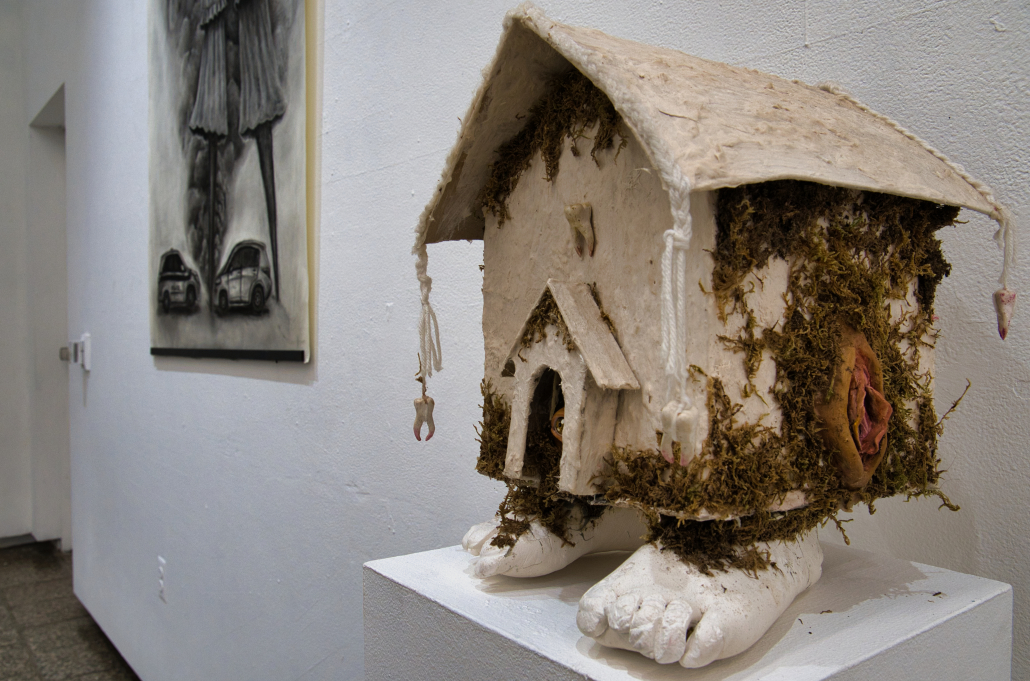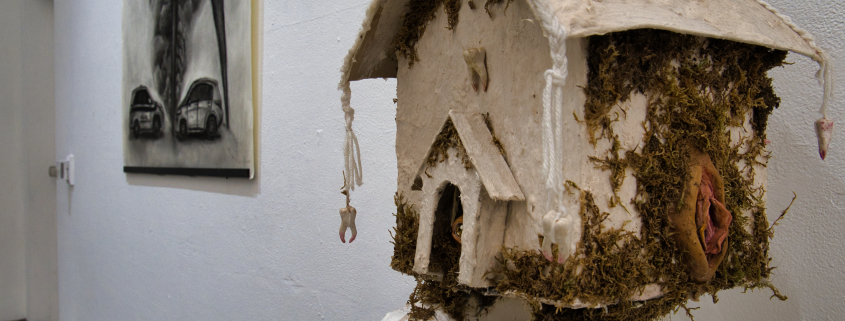Roski student’s exhibit on folklore, familial identity

Whose stories are told? What do those stories say about how history and magical folklore intersect? Where does one fit into these ancestral stories that are either lost to time or intentionally hidden? These are questions that USC senior Seanna Latiff comments on in her exhibition, “often heard, but rarely seen,” which is currently on view at the Helen Lindhurst Fine Arts Gallery in Watt Hall.
The exhibition — which covers all four walls of the gallery, a feat Latiff is particularly proud of — is the result of her trip to Trinidad and Tobago that she funded with Roski’s Macomber Travel Grant she was awarded last spring. Latiff was born in Trinidad and immigrated to the United States when she was six years old. Her Macomber Grant trip was her first time returning to the country in 11 years.
“There is a wealth of stories [in Trinidad and Tobago],” Latiff said. “Not just stories for stories’ sake, but stories rooted in history and rooted in resilience through oppression.”
These stories are woven throughout Latiff’s work and the richness of Trinidadian folklore shines alongside her own family’s history. One work, which spans an entire wall of the gallery hall, incorporates family pictures from Trinidad’s Carnival, images of indigenous Trinidadian history and a contemplative text monologue in the background. In the top left corner of the work sits a pygmy owl, a Trinidadian symbol of death and the inspiration for the exhibition’s title.
The pygmy owl appears in several of Latiff’s works in the exhibition and serves as an omnipresent reminder of death — not a grim, overpowering fear but a quieter symbol of ancestry and heritage.
“So much of my practice is about death, and it’s not the dark and gloomy aspect of it, but about … alchemizing those feelings and seeing how [to] shine light on what we’re afraid of,” Latiff said.
This is not to say that Latiff’s work shies away from more visceral aspects of death and the human body. Some of her self-portraits and her zine (a small self-published artwork in magazine form), “Birdshit,” border on body horror. In these works, Latiff often represents herself as a patchwork, commenting on her multicultural identity.

Seanna Latiff said Soraya Latiff, her sister, was an important inspiration for the exhibit. In one of the most striking works, a clear portrait of Soraya Latiff sits cross-legged, with family matriarchs resting their hands on her shoulders, their faces notably blurred and lost to time.
The first work Seanna Latiff created specifically for the exhibition shows her and Soraya as young girls enveloped in the wings of a large owl. Seanna Latiff said that this owl is meant to represent the Chickcharney, a mythological creature. According to Trinidadian folklore, the owl is both a protector and a symbol of death and habitat loss. In this work, as in many others of her portraits, Seanna Latiff draws an explicit connection between magic and her place in her culture.
Referencing the title of her exhibition, owls are often heard but unseen in the gallery space. “A Call to Owls,” an auditory work created by one of Seanna Latiff’s friend, April Levin, combines bird calls and crashing waves and plays on a loop in the gallery hall. Taken in conjunction with Seanna Latiff’s visual works, the audio’s mood changes: Sometimes it is mysterious, other times somber and other times almost welcoming.
Her artistic process? “Screaming, crying, throwing up,” Seanna Latiff said. She chose to represent this process through a self-portrait in which she painted herself as Soucouyant, a woman who, according to Trinidadian folklore, sheds her skin each night to become a raging ball of fire.
“I’d like to leave you with the knowing that magic is real,” Seanna Latiff wrote in a note near the visitor log book. “The best is yet to come.”
This article has been edited to protect the privacy of people mentioned and provide clarity.

